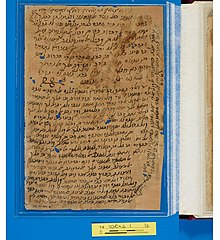
Back More Nevuchim ALS دلالة الحائرين Arabic Пътеводител за заблудените Bulgarian Guia de perplexos Catalan Moré Nevukhim Danish Führer der Unschlüssigen German Guía de los Perplejos Spanish Alderraien gidaria Basque دلالة الحائرین Persian Guide des égarés French
 Maimonides' autograph draft of Dalālat al-ḥā'irīn, written in Standard Arabic with Hebrew script, from the Cairo Genizah[1] | |
| Author | Moses Maimonides |
|---|---|
| Original title | דלאלת אלחאירין |
| Language | Judeo-Arabic |
| Genre | Jewish philosophy |
Publication date | c. 1190 |
| Publication place | Ayyubid Empire |
Published in English | 1881 |
| Media type | Manuscript |
| 181.06 | |
| LC Class | BM545 .D3413 |
| Text | The Guide for the Perplexed at Wikisource |
The Guide for the Perplexed (Judeo-Arabic: דלאלת אלחאירין, romanized: Dalālat al-ḥā'irīn; Arabic: دلالة الحائرين, romanized: Dalālat al-ḥā'irīn; Hebrew: מורה הנבוכים, romanized: Moreh HaNevukhim) is a work of Jewish theology by Maimonides. It seeks to reconcile Aristotelianism with Rabbinical Jewish theology by finding rational explanations for many events in the text.
It was written in Judeo-Arabic, a dialect of Classical Arabic using the Hebrew alphabet. It was sent originally, part after part, to his student, Rabbi Joseph ben Judah of Ceuta, the son of Rabbi Judah, and is the main source of Maimonides' philosophical views, as opposed to his opinions on Jewish law.
Since many of the philosophical concepts, such as his view of theodicy and the relationship between philosophy and religion, are relevant beyond Judaism, it has been the work most commonly associated with Maimonides in the non-Jewish world and it is known to have influenced several major non-Jewish philosophers.[2] Following its publication, "almost every philosophic work for the remainder of the Middle Ages cited, commented on, or criticized Maimonides' views."[3] Within Judaism, the Guide became widely popular, with many Jewish communities requesting copies of the manuscript, but also quite controversial, with some communities limiting its study or banning it altogether.
- ^ "Cairo Genizah : Philosophy".
- ^ For example, Joseph Telushkin noted that "Thomas Aquinas refers in his writings to "Rabbi Moses", and shows considerable familiarity with the Guide. "Maimonides". Retrieved 2007-10-10. at the Jewish Virtual Library; also Leibniz wrote a commentary on the Guide.
- ^ Encyclopaedia Judaica, "Moses Maimonides". Archived from the original on 2008-12-24. Retrieved 2007-10-11. Second Edition, Volume 13, p. 388.